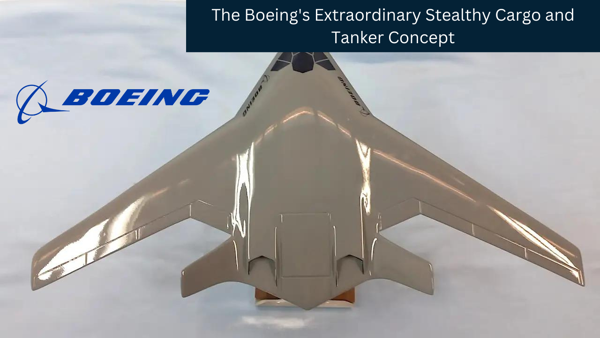
Defence & Security
Boeing Unveils Its "Extraordinary" 5th Generation Stealthy Tactical Cargo And Tanker Concept Design to Replace The Most Efficient Old Guards, C-130 Hercules And C-17 Globemaster II
The United States Air Force, the world's most powerful military power, is looking for a stealthy and environmentally efficient tanker and transport aircraft.
To quench the thrust of the USAF, Boeing has come up with a concept, displayed at, the AIAA Sci Tech, forum and exhibit put on by the "American Institute of Aeronautics and Astronautics" in Fort Washington, Maryland.
The Pentagon is desperately looking forward to an efficient and economical concept design of an advanced configuration that would provide a wide range of advantages over the recently use cargoes based on the Boeing 767 and Airbus 330 families of commercial and military aircraft.
The Pentagon and USAF are looking forward to an aircraft that will be stealthy, more aerodynamically efficient, and more environmentally friendly because tanker and passengers aircraft consume a significant amount of gasoline and emit aerosol that hurt our environment to a great extent, Some of the damage done by the aircraft is irreversible.
In response to the Pentagon's demand Boeing company has come up with an excellent concept design to replace the "old guard" transport aircraft, C-130 Hercules and C-17 Globemaster.
The concept design is based on "Blend Wing Body Aircraft", the best examples of the BWB aircrafts are the American bombers B-2 and B-21, manufactured by Northman Grumman.
The new design will be 30% more aerodynamically efficient, with increased range, loitering time, and offload capabilities.
Keeping Biejing in mind:
The Pentagon desires such passenger and tanker aircraft while keeping Beijing's capability in mind.
The United States's more formidable adversary at the moment is China, not Russia, and the US is well aware that China has developed the capability to detect and shoot down any American aircraft flying over the Pacific, where the possibility of war looms due to China's overambitious Greater China concept after conquering Taiwan.
Although, Chinese platforms are all based on the Russian military model. And China has already developed the hypersonic missile system to deter the mighty American carrier fleet.
China is working on some future technologies like Electromagnetic rail guns, China's version of the "Mother of all bombs", D-26 carrier killer missiles, technologies regarding super soldiers, stealthy bombers, upgraded stealthy fighters, and upgraded bunkers to protect increase their nuclear striking capabilities.
Therefore, to fight a high-end war, the Pentagon is looking to develop a transport aircraft as well as a tanker capable of carrying logistics without being detected by Chinese radars; if the aircraft has a low radar signature, its survivability will increase automatically.
Boeing's Work Experience With BWB:
Boeing does have a long history of work related to BWB designs. Boeing has already worked with NASA on a prototype BWB, the X-48. They worked under the concept of NASA between the late 2000s and early 2010s.
Boeing not only worked on that project, but they also built a prototype to test the flight performance of the uncrewed subscale design, the X-48.
In comparison to the latest concept design, previous Boeing BWB concepts, such as the X-48 series, featured wider, more rounded fuselages and noses and engines positioned in pods on top of the center of the rear fuselage.
Boeing also contributed to the Pentagon's Speed Agile concept. The idea was to replace the C-130 Hercules with a stealthy tanker fleet and passenger fleet.
Tankers are very important to refuel the fighters and reconnaissance aircraft in the air without landing the aircraft, which will increase the efficiency of the battle harden group during the time of ultimate war environment.
The US air force has already started working on the project to replace their error-ridden KC-46A tanker groups.
The USAF has already launched the KC-Y "Bridge Tanker" Program. The name KC-Y "Bridge Tanker" has been given to the program because the next tanker will come between the current KC-46A and the next-generation KC-Z family of area refueling systems.
The US is looking to develop the next-generation tankers and passengers keeping some advantages of BWB in the mind.
Advantages and Disadvantages of BWB:
The BWB aircraft are aerodynamically efficient and can convert a large number of cargoes and tankers over a long distance at a low direct operating cost.
The design also provides environmental benefits and is suitable for the integration of advanced systems and concepts like "Laminar Flow Technology", "Jet Flaps", and "Distributed propulsion".
The BWB design also creates more space in the fuselage to carry more load in a single journey.
These advantages make the aircraft more durable, survivable, and with high capacity.
However, the aircraft has some challenges regarding issues of control and stability, cabin pressurization, and aircraft handling qualities.
The above challenges are holding this remarkable design to become a reality since the cold war era.
But, the USAF is looking forward to developing an aircraft that will seriously challenge China's dominance in the Indo-Pacific region this time.
China is challenging the dominance of the US in this region in a serious manner by developing six fleets of aircraft carriers. The Chinese navy is already the world's largest navy with the largest number of submarines and other vessels.
As an isolated power, the US cannot challenge the Chinese in this region; they must rely on India for assistance, and India will gladly extend its hand to assist the US in fighting the Chinese autocracy in this region.
The US may not sell its strategic passenger aircraft to India but India has to help the United States unconditionally to counter Chinese aggression against Taiwan because Taiwan is a strategically important country from the point of view of the economy.

0 Comments